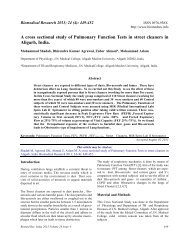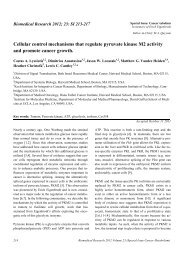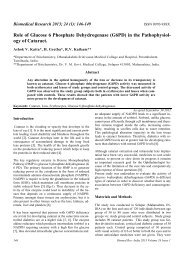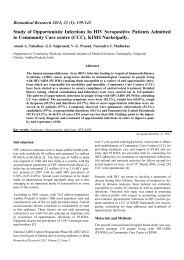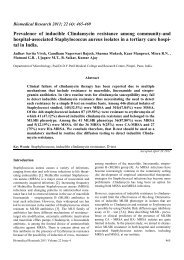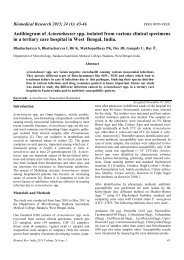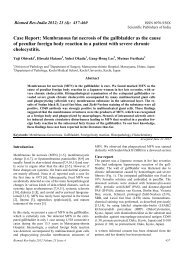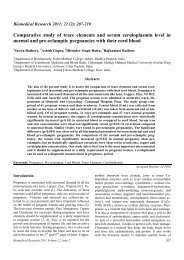Comminuted fracture with butterfly fragment of the humerus ...
Comminuted fracture with butterfly fragment of the humerus ...
Comminuted fracture with butterfly fragment of the humerus ...
You also want an ePaper? Increase the reach of your titles
YUMPU automatically turns print PDFs into web optimized ePapers that Google loves.
<strong>Comminuted</strong> <strong>fracture</strong> <strong>of</strong> <strong>the</strong> <strong>humerus</strong> during arm wrestlingThis article must be cited as:Hyun-Soo Kim, Young Ho Shin, Youn Wha Kim. <strong>Comminuted</strong> <strong>fracture</strong> <strong>with</strong> <strong>butterfly</strong> <strong>fragment</strong> <strong>of</strong> <strong>the</strong> <strong>humerus</strong> sustainedduring arm wrestling. Biomed Res- India; 2013; 24 (3): 320-323.DiscussionIntense muscular contractions can be a mechanism <strong>of</strong> injuryin various sports and can affect various bones. Thehumeral shaft <strong>fracture</strong> during arm wrestling occurs whenmoments <strong>of</strong> torsional forces induced by intense muscularcontractions are transmitted onto it. The moments <strong>of</strong> <strong>the</strong>seforces are resultant <strong>of</strong> forces acting in <strong>the</strong> direction <strong>of</strong>internal rotation by <strong>the</strong> pectoralis major, latissimus dorsi,teres major and subscapularis, and resultant <strong>of</strong> externalrotational forces applied by <strong>the</strong> opponent and transmittedby <strong>the</strong> long forearm lever through <strong>the</strong> elbow. In both cases<strong>the</strong> results <strong>of</strong> opposite directional forces occur thanksto <strong>the</strong> work <strong>of</strong> <strong>the</strong> internal rotator shoulder muscles.When <strong>the</strong> dominant competitor exerts force, <strong>the</strong> internalrotator muscles <strong>of</strong> <strong>the</strong> opponent undergo rapid stress from<strong>the</strong>ir maximum concentric contraction to eccentric passivecompensatory relaxation, causing an increase in <strong>the</strong> humeralrotational force. This results in <strong>the</strong> transmission <strong>of</strong><strong>the</strong> stress through <strong>the</strong> distal part <strong>of</strong> <strong>the</strong> arm and elbow,causing a shifting <strong>of</strong> <strong>the</strong> maximum force to <strong>the</strong> <strong>humerus</strong>and its <strong>fracture</strong>. Nyska et al. [15] note that <strong>the</strong> <strong>fracture</strong> isusually in <strong>the</strong> distal third <strong>of</strong> <strong>the</strong> <strong>humerus</strong>, and suggest that<strong>the</strong> forces acting on <strong>the</strong> <strong>humerus</strong> are bending, axial compressionand torsional forces, while <strong>the</strong> flexor muscles <strong>of</strong><strong>the</strong> forearm are forcefully contracted.In our case, we could easily consider <strong>the</strong> possibility <strong>of</strong>humeral <strong>fracture</strong> <strong>with</strong> <strong>the</strong> patients’ clinical presentations,so we performed imaging studies <strong>with</strong>out any hesitations.Some <strong>fracture</strong>s, however, which are not related to director indirect contact forces, can be missed if <strong>the</strong>y do notcause severe symptoms. Intense muscular contractionsrelated<strong>fracture</strong>s <strong>of</strong> protruded bone, such as those <strong>of</strong> <strong>the</strong>olecranon, anterior superior ischial spine <strong>of</strong> <strong>the</strong> pelvis andfifth metatarsal base <strong>of</strong> <strong>the</strong> foot, are good examples. We<strong>the</strong>refore suggest that a diagnosis <strong>of</strong> <strong>fracture</strong> should beconsidered in cases <strong>of</strong> intense muscular contractions. Acareful history taking and radiologic examination willenable to prevent misdiagnosis and mismanagement.Every long bone <strong>fracture</strong>s do not require computed tomographyscanning routinely, but in our case, we performedit due to <strong>the</strong> presence <strong>of</strong> a large <strong>butterfly</strong> <strong>fragment</strong>. With<strong>the</strong> understanding <strong>of</strong> three-dimensional morphology <strong>of</strong><strong>fracture</strong> site as well as its location, we could decide properoperative methods. Also, <strong>fracture</strong> <strong>of</strong> <strong>the</strong> distal one third<strong>of</strong> <strong>humerus</strong> is deeply associated <strong>with</strong> <strong>the</strong> occurrence <strong>of</strong>radial nerve palsy. Of <strong>the</strong> few complications <strong>with</strong> <strong>humerus</strong><strong>fracture</strong> sustained during arm wrestling that have beenreported, <strong>the</strong> most common is radial nerve palsy, whichusually manifests as wrist drop. It can be caused by direct322damage due to <strong>the</strong> <strong>butterfly</strong> <strong>fragment</strong>, so it is very importantto understand <strong>the</strong> morphology <strong>of</strong> <strong>the</strong> <strong>fracture</strong> site.For <strong>the</strong> treatment <strong>of</strong> such injury, conservative managementwas mainly recommended at past. However, because<strong>of</strong> developed instruments and increased patients’ requirements,operative treatments have been recently performedby many orthopedic surgeons.In summary, <strong>the</strong> present case illustrates that <strong>the</strong> extremelyhigh indirect forces generated by sudden intense muscularcontractions during arm wrestling can cause a comminuted<strong>fracture</strong> <strong>of</strong> <strong>the</strong> <strong>humerus</strong>. Severe pain in arm wrestlersshould not be attributed solely to musculoskeletal sprainsand ruptures. All patients who present <strong>with</strong> histories <strong>of</strong>sudden arm pain after arm wrestling should receive appropriateradiologic studies and a careful neurologic examinationto exclude <strong>fracture</strong> and prevent misdiagnosisand mismanagement. This type <strong>of</strong> <strong>fracture</strong> may occur inanyone <strong>of</strong> any age engaging in this type <strong>of</strong> sport. Especially,amateurs are injury-prone because <strong>the</strong>y use badwrestling techniques. Because <strong>of</strong> <strong>the</strong> possibility <strong>of</strong> participantssustaining such an injury, arm wrestling shouldnot be considered a totally benign injury.AcknowledgementsThe views and opinions expressed in this article are those<strong>of</strong> <strong>the</strong> author and do not reflect <strong>the</strong> <strong>of</strong>ficial policy or position<strong>of</strong> <strong>the</strong> Republic <strong>of</strong> Korea Air Force or Republic <strong>of</strong>Korea Ministry <strong>of</strong> National Defense. The author thanksmedical librarian Ja Ok Kim (Aerospace Medical Library,Aerospace Medical Center, Republic <strong>of</strong> Korea Air Force)for her assistance in searching for literature.References1. Brinker MR, O'Conner DP. The incidence <strong>of</strong> <strong>fracture</strong>sand dislocations referred for orthopaedic services in acapitated population. J Bone Joint Surg Am 2004; 86:290-297.2. Fenyo G. On <strong>fracture</strong>s <strong>of</strong> <strong>the</strong> shaft <strong>of</strong> <strong>the</strong> <strong>humerus</strong>: areview covering a 12-year period <strong>with</strong> special consideration<strong>of</strong> <strong>the</strong> surgically treated cases. Acta Chir Scand1971; 137: 221-226.3. Baker DM. Fractures <strong>of</strong> <strong>the</strong> humeral shaft associated<strong>with</strong> ipsilateral <strong>fracture</strong> dislocation <strong>of</strong> <strong>the</strong> shoulder: report<strong>of</strong> a case. J Trauma 1971; 11: 532-534.4. Chao SL, Miller M, Teng SW. A mechanism <strong>of</strong> spiral<strong>fracture</strong> <strong>of</strong> <strong>the</strong> <strong>humerus</strong>: a report <strong>of</strong> 129 cases following<strong>the</strong> throwing <strong>of</strong> hand grenades. J Trauma 1971; 11:602-605.5. Reed WJ, Mueller RW. Spiral <strong>fracture</strong> <strong>of</strong> <strong>the</strong> <strong>humerus</strong>in a ball thrower. Am J Emerg Med 1998; 16: 306-308.Biomed Res- India 2013 Volume 24 Issue 3



